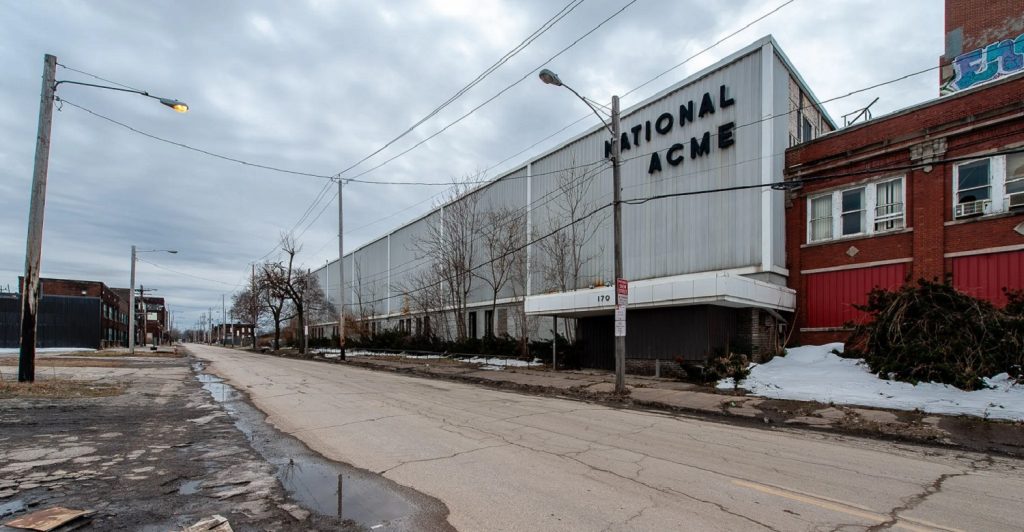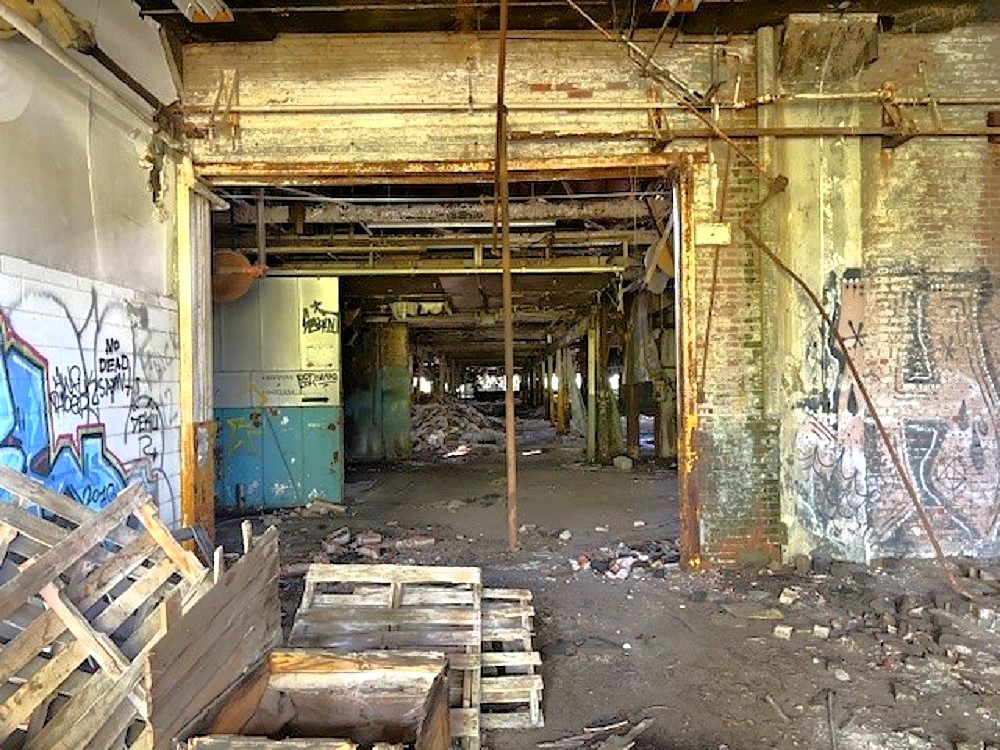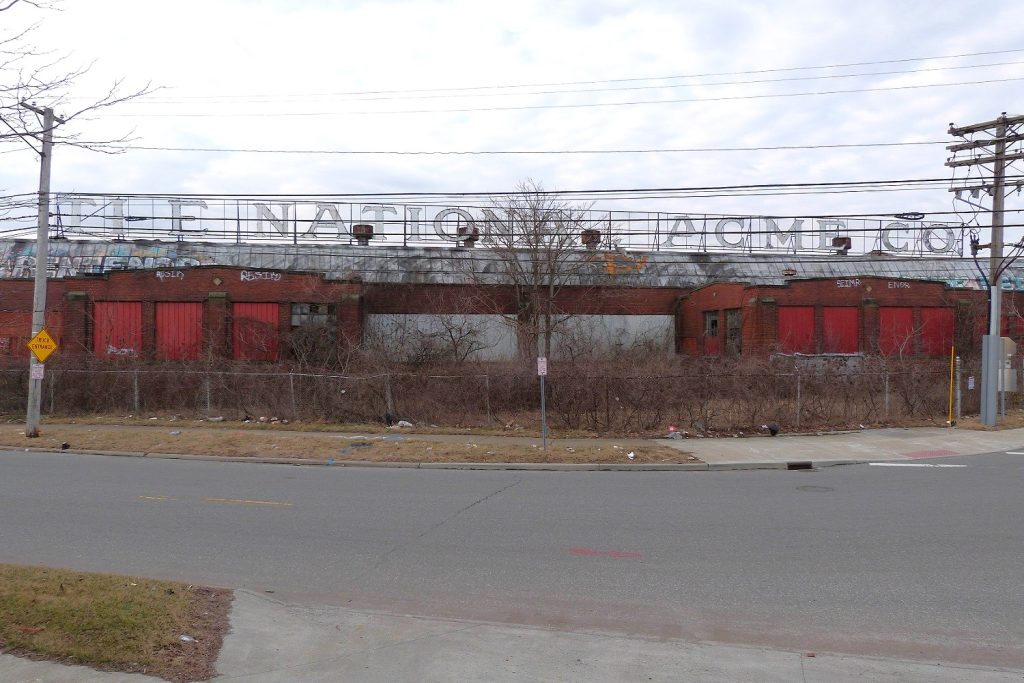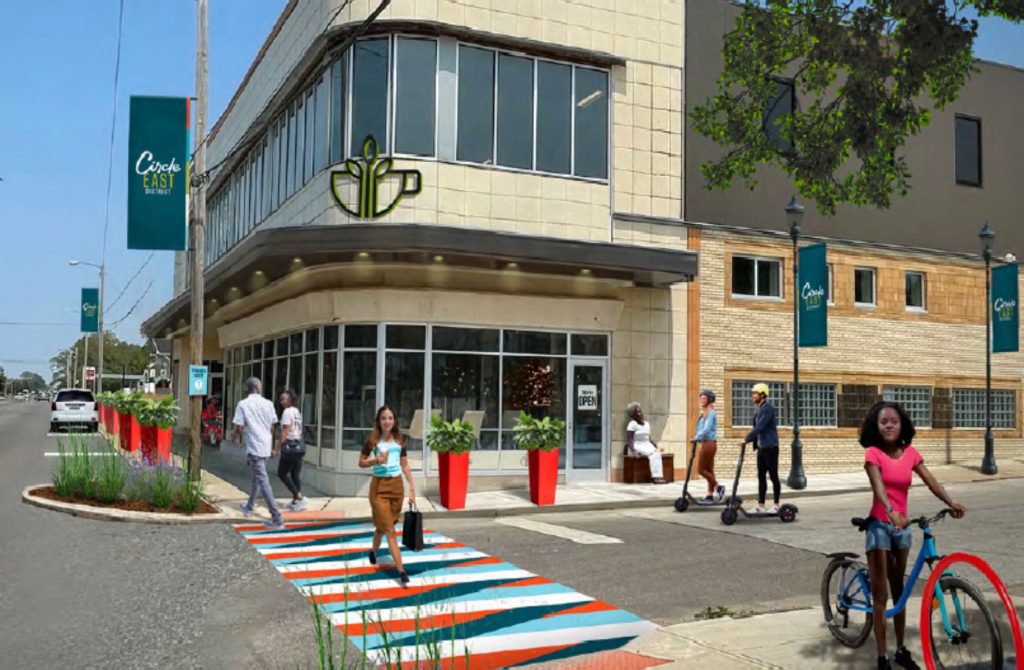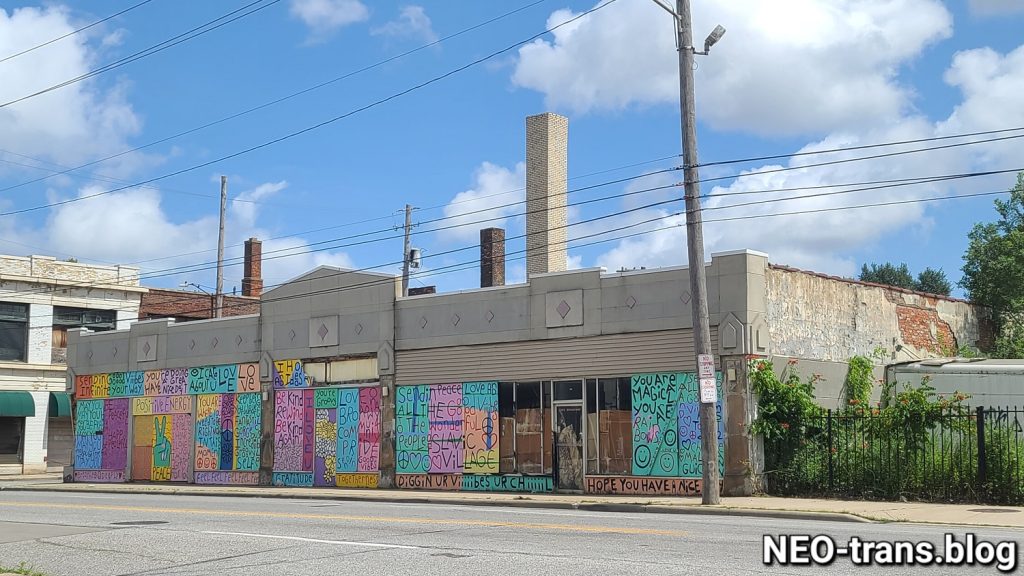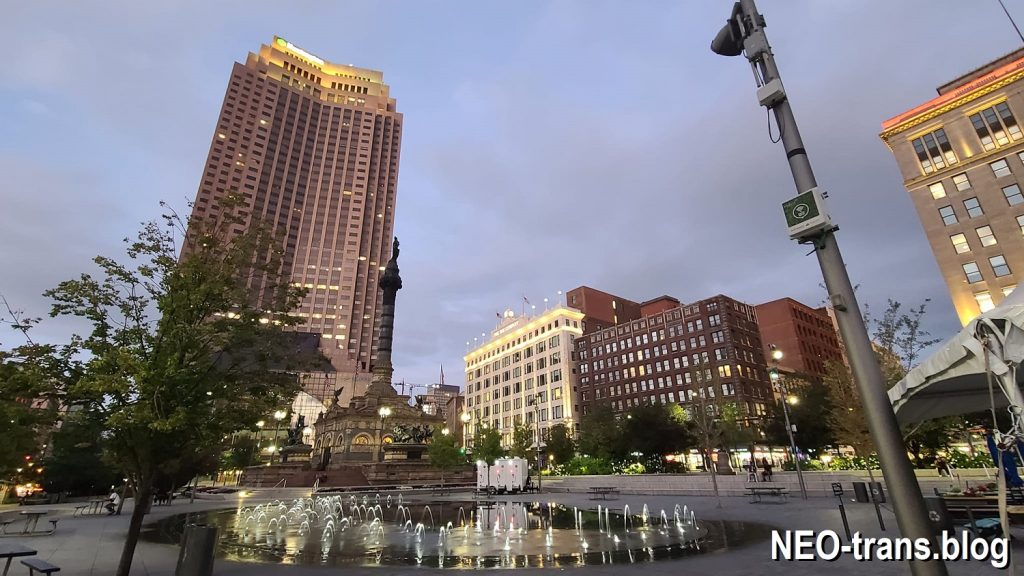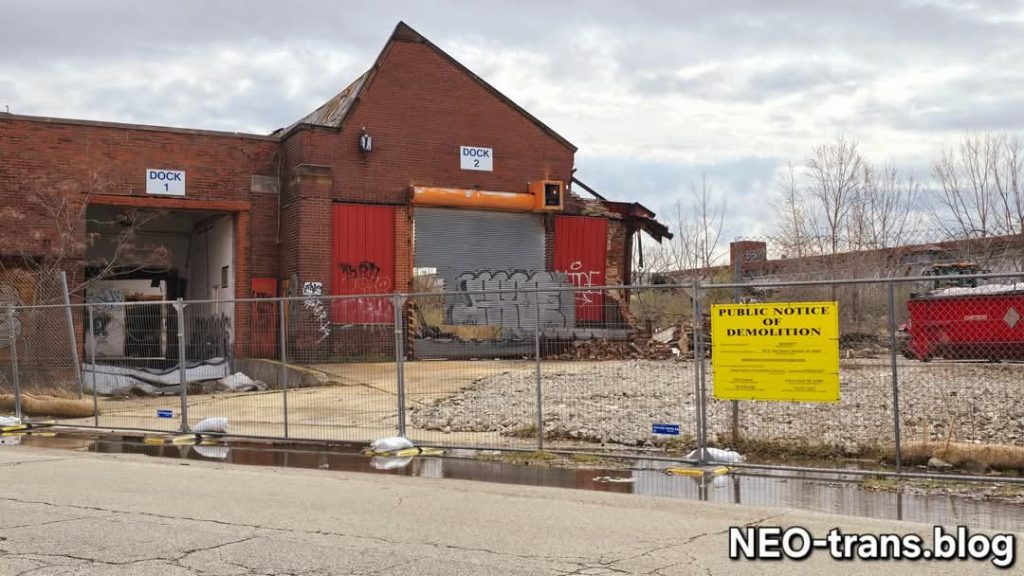
Long abandoned and neglected, the former National Acme plant on East 131st Street at Coit Road is getting demolished and its site cleaned up to make way for a new end user offering new jobs for Cleveland’s Glenville and Collinwood neighborhoods. And now it will expand with the addition of a neighboring former Republic Steel site (Cuyahoga Land Bank). CLICK IMAGES TO ENLARGE THEM.
Demolition, cleanup of toxic site starts today
The fate of the National Acme plant at 170 E. 131st St., where Cleveland’s Glenville and Collinwood neighborhoods meet, is an all-too common story about the demise of a major employer-turned-abandoned factory. But community leaders today said they hope that the rebirth promised for this neglected, toxic site will also become a common story for Cleveland’s many problematic properties.
And the National Acme site’s 15 acres is about to expand by 22 acres with the pending, under-contract acquisition of the neighboring, vacated Republic/LTV Steel fabrication center property, 12610 Kirby Ave. The addition of that site to National Acme’s will make the combined 37-acre redevelopment canvas much more marketable. It is also now the largest development site in Cleveland.
The Site Readiness for Good Jobs Fund (SRF), in partnership with the City of Cleveland and Cuyahoga Land Bank, broke ground today on the highly anticipated cleanup and redevelopment of the former National Acme site. And they announced they have secured a purchase agreement for the ex-Republic/LTV Steel site, as well.
Mayor Justin Bibb described the $11 million demolition and clean-up of the 15-acre portion as a “pivotal transformation” for the surrounding community which has had to put up with it as a nuisance for years after National Acme’s successor relocated to a more modern factory in suburban Twinsburg. The plant’s owners in the 2010s used it as an illegal recycling center, ultimately sending three of its proprietors to prison on felony charges.
“This project is more than just demolition — it’s a commitment to Cleveland’s economic future,” Lt. Governor Jim Tressel said in a written statement. “By transforming long-neglected spaces into opportunities for growth through our Brownfield Remediation Grants, we’re paving the way for new jobs, new investment and a stronger community.”
“This isn’t just a cleanup; it’s a commitment to a healthier, safer, and more prosperous future for East Glenville and Collinwood,” said Ward 8 Councilman Mike Polensek. “For too long, this site has been a barrier to growth. Now it will be a foundation for opportunity. From the day I became councilman for that area, I was determined to reimagine and repurpose this historic site.”
The cleanup effort will remove asbestos, clear waste, demolish remaining structures and remediate soil contamination — paving the way for economic development and new jobs, and positioning Cleveland to finally compete in Ohio’s large business expansion efforts, said Ward 10 Councilman Anthony Hairston.
SRF Managing Director Brad Whitehead highlighted the “enormous potential” of the site. And SRF’s addition of the Republic/LTV Steel site will allow it to hit the 30-plus acres mark, which he said is the “sweet spot” for becoming more marketable to potential end users and employers. Terms of the pending acquisition were not disclosed.
“It’s a massive site with amazing freeway and rail access, surrounded by a ready and capable workforce of nearly 100,000 people within a 30-minute walk, bike or bus commute,” Whitehead said.
In February, the Cuyahoga Land Bank hired Clean Harbors Environmental Services Inc. of Norwell, Mass. to demolish and clean up the National Acme site, according to public records. It is just one of many sites throughout Greater Cleveland that are being targeted by the land bank, SRF and others to reactivate former job sites with new ones.
SRF was established in August 2023 by Bibb and City Council with $50 million in seed funding. The nationally unique nonprofit aims to breathe new life into 1,000 acres of neglected real estate, catalyzing the creation of 25,000 jobs, supporting neighborhood vitality, building wealth among residents and enhancing environmental sustainability.
SRF’s fiscal agent is the Cuyahoga Land Bank. The land bank won a $7.6 million grant last year from Ohio’s Brownfield Program to clean up the National Acme property. In its application, the land bank anticipated landing an end user who could offer at least 150 permanent jobs.
Since its formation in 2009, the Cuyahoga Land Bank has demolished more than 10,000 blighted properties, renovated over 2,600 homes and facilitated the construction of approximately 250 new residences. The land bank estimates its economic impact at $3.6 billion by increasing property values, attracting private investments, restoring property tax revenue and improving neighborhood stability.
The historic plant, built in 1917 as a major machine-tool manufacturing hub, employing more than 1,000 workers at its mid-20th century peak. National Acme became Acme-Cleveland Corp. in 1968 by merging with the Cleveland Twist Drill Co., founded in 1876.
Company-wide, Acme-Cleveland had more than 15 factories and 6,300 employees in 1980 with annual revenues of about $5 billion, according to abandonedonline.net. But cheaper foreign competition soon eroded its business to the point the firm had to sell off pieces of itself to survive.
The East 131st plant was operated by DeVlieg-Bullard Inc. in 1995 and Acme-Cleveland’s stock was bought by Danaher Corp., a conglomerate. DeVlieg-Bullard filed for Chapter 11 bankruptcy in 1999, and the factory was sold to a real estate holding company Acme Realty LLC the next year.
A portion of the plant was leased back to DeVlieg-Bullard but it steadily moved operations to a more modern plant in suburban Twinsburg. Acme Realty leased the East 131st factory to All Points in 2011 for a cardboard and paper waste recycling facility.
But a portion of the factory was razed illegally. During demolition, asbestos fibers were released into the environment. Also, piles of debris and asbestos were left out in the open, exposed to the wind and elements, subjecting nearby residents to multiple health hazards, resulting in criminal convictions against its proprietors.
The abandonment and neglect of this site and others nearby caused distress, disinvestment and decay of the surrounding community. Median household income for the community averages about $27,787, well below the state’s median housing income of $61,938, according to the Cuyahoga Land Bank.
Also, the community’s 37 percent poverty rate is nearly triple the statewide rate, education levels fall well short of statewide averages and the community is riddled with vacant structures. Those living in the community are also exposed to greater environmental hazards than the average Ohioan, and are less healthy than most of the state.
END

